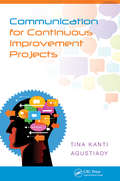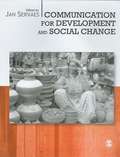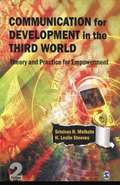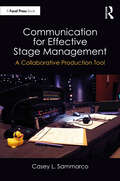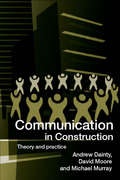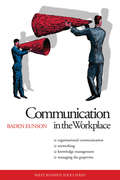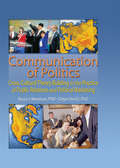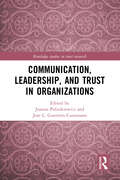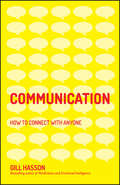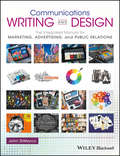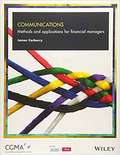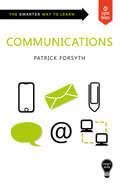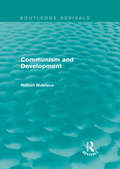- Table View
- List View
Communication for Continuous Improvement Projects
by Tina AgustiadyManufacturing companies work endlessly to make process improvements, yet they are often hard to implement and even harder to sustain. The reason: companies often stumble when communicating why the methodologies are being used and how to sustain the improvements. Communication for Continuous Improvement Projects demonstrates how to communicate chang
Communication for Development and Social Change
by Professor Jan ServaesThis volume is first and foremost about people and the processes needed to facilitate sharing of knowledge in order to effect positive developmental change. It is contextual and based on dialogue necessary to promote stakeholder's participation, which is essential for the understanding of their perceptions, perspectives, values, attitudes and practices, so that these can be incorporated into the design and implementation of development initiatives. This volume follows the two-way horizontal model and increasingly makes use of many-to-many forms of communications to facilitate the understanding of people's perceptions, priorities and knowledge with its use of a number of tools, techniques, media and methods. It aims to give voice to those most affected by the development issue(s) at stake, allowing them to participate directly in defining and implementing solutions and identifying development directions. Based on the assumption that authentic participation directly addresses power and its distribution in society, which often decreases the advantage of certain elite groups, the authors argue that structural and sustainable change necessitates the redistribution of power. This collection offers perceptive insights and vivid examples to prove that the field of communication for development and social change is indeed vibrant.
Communication for Development in the Third World
by H Leslie Steeves Srinivas Raj MelkoteThis completely revised edition builds on the framework provided by the earlier text. It traces the history of development communication, presents and critiques diverse approaches and their proponents, and provides ideas and models for development communication in the new century.
Communication for Effective Stage Management: A Collaborative Production Tool
by Casey L. SammarcoCommunication for Effective Stage Management: A Collaborative Production Tool provides a comprehensive examination of communication theory through the lens of effective stage management and offers ideas and methods for stage managers to enhance their communicative presence throughout a theatrical process.This book offers new, extensive in-depth discussion of communication techniques and how these methods apply to the role of the theatrical stage manager as the facilitator of information. Part I dives into the methods and principles of business communication employed by stage managers and discusses how these techniques are best implemented throughout a theatrical process, all supported with real-life examples. It also offers discussion questions and resources to enhance the content and encourages the reader to self-analyze their own communication techniques during the production process. Part II contains excerpts from other industry professionals who offer their own unique perspective as to the collaborative and communicative work of stage managers and how their own artistic careers are impacted by the communication systems of a stage management team.This book is best suited for advanced stage management students, professional theatre practitioners, and theatrical educators.
Communication in Construction Teams (Spon Research)
by Stephen Emmitt Christopher GorseConstruction teams are usually complex, interdisciplinary and temporary, and, as such, the need for effective communication is crucial. However, published data regarding the manner in which individuals interact within the temporary project team is scarce, with little other than anecdotal evidence available. Recognizing this gap, Communication in Construction Teams provides a comprehensive overview of the literature on interpersonal communication and delivers a critical review of various research methods previously used in and outside the construction management field. Making use of Bales' interaction process analysis (IPA), a tool used successfully in many fields to collect interaction data, the text investigates the link between successful projects and the effectiveness of communication, finding that participants in the construction process exhibit regular patterns of interaction and, most significantly, that there are different patterns of interaction associated with successful and unsuccessful projects. Putting forward a number of practical suggestions to assist all actors involved in construction projects, this insightful publication will be of interest to researchers in the fields of building design and construction management.
Communication in Construction: Theory and Practice
by Michael Murray David Moore Andrew DaintyCommunication within project-based environments presents special challenges. This is especially true within the construction industry, where interaction tends to be characterised by unfamiliar groups of people coming together for short periods before disbanding to work on other endeavours. This book examines communication at a number of levels ranging from interpersonal interactions between project participants to corporate communication between organizations. Several non-typical perspectives on the process of communication are introduced to encourage the reader to think about communication in a more innovative manner. The combination of differing perspectives illustrates the diversity of communication problems facing those working within project-based environments. Practical guidance is provided on possible solutions to communication problems, and a number of examples and case studies are presented.
Communication in Organizational Environments: Functions, Determinants and Areas of Influence
by Anna Rogala Sylwester BialowasThis book showcasesan interdisciplinary and comprehensive study of the issues related tocommunication in corporate environments. Including perspectives frompsychology, sociology and management science, Communication in Organizational Environments analyzes originalquantitative and qualitative research, and determines the functions, objectivesand conditions of effective internal communication. In this book, the authorsbridge the gap in the literature on the management of corporate internal communication,and provide a tool for measuring communication effectiveness. Useful as a guidefor internal communication managers in various organizations, this book is alsoimportant reading for academics in corporate communication, public relations,corporate management and behaviour, and human resource management.
Communication in Sport Management (Routledge Research in Sport Business and Management)
by Paul M. PedersenThis book presents cutting‑edge perspectives on Communication in Sport Management, a core component of contemporary sport business.Featuring the work of leading sport scholars from around the world, this book explores seven key themes in sport communication: engagement, technology, branding, publicity, finance, health, and crisis communication. Drawing on multi‑disciplinary perspectives, including communication and media studies, management, finance, and sociology, this book examines cutting‑edge topics such as digital sport fandom, online abuse, communication in esports, developing athlete brands, and managing scandal.Offering an important snapshot of the state of the art in sport communication, this book is fascinating reading for any advanced student, researcher, policy maker, or practitioner working in sport business and management, sport media, digital media, public relations, or broadcasting.
Communication in the workplace
by Baden EunsonCommunication in the Workplace is a revealing snapshot of how organisations really work. In workplaces throughout Australia and across the planet, billions of messages are sent in various forms every day, but not all of them get though. Of those that do, may are misunderstood, Communication breakdown is just as common as communication effectiveness, but it doesn't have to be that way. Become a more effective communicator by finding out how messages can be sent -- and distorted -- by differing channels, including: memos emails meetings teleconferencing instant messaging Expert communicator Baden Eunson shares insights about the informal organisation, networking, how to know when messages are being lost due to cultures of silence, silos or empires (and what to do about it), and explains how knowledge management can help you get your message across.
Communication of Politics: 8th Inte
by Bruce I NewmanLearn how political marketing and public relations affect the electoral process! Communication of Politics: Cross-Cultural Theory Building in the Practice of Public Relations and Political Marketing examines how communication and marketing experts influence politics. The book reviews the state of the art in political communication management and marketing through a cross-cultural integration of research and theoretical approaches. An international panel of authors presents a comparative assessment of the impact of candidate and party appeals on the electorate, examines case studies from elections in the United States and Europe, and offers innovative models of voter behavior in the United States, Poland, and Slovenia. Communication of Politics provides valuable insights into the merger of political marketing and public relations. The book examines the cause and effect of the increasing role of communications professionals in the political process and documents the relationship between politicians and communications professionals working in electoral committees, political parties, governments, government agencies, consultancies, and polling agencies. Topics addressed by the international panel of scholars and practitioners include: a critical assessment of strategies used in the 2000 United States Presidential election branding as a means of establishing party values and winning support the expanding roles of polls, focus groups and Internet-based research on elections the relationship between foreign affairs/diplomacy and media/public relations Quangos (Quasi-Autonomous Non-Governmental Organizations) and much more! Communication of Politics: Cross-Cultural Theory Building in the Practice of Public Relations and Political Marketing examines the innovative-and sometimes controversial-uses of contemporary electoral marketing. The book is an essential resource for academics, journalists, and political practitioners, including campaign managers, charity fundraisers, public service managers, party-policy-makers-even candidates.
Communication, Advocacy, and Work/Family Balance (Routledge Research in Communication Studies)
by Jenny DixonThis book presents an understanding of work-family balance for working adults belonging to a number of different family structures (e.g. single and/or childfree adults, LGBT couples, families with female breadwinners). It contends that family structure should serve as a way of thinking about diversity (i.e., race, gender, age, family) in the U.S. workplace. It also argues that—in addition to accommodations occurring through workplace policy—the negotiation of work-family balance happens as a result of self-advocacy that occurs in everyday communication about family at work. Relaying the stories of a number of different working adults belonging to a variety of different family structures, it explores the range of obstacles faced in the attempt at balancing work and family life, generates informed ideas for eliminating barriers commonly experienced in balancing work and family, and problematizes enduring assumptions regarding gender roles and the myth of steadfast public and private spheres.
Communication, Leadership and Trust in Organizations (Routledge Studies in Trust Research)
by Joanna Paliszkiewicz Cusumano, Jose L. GuerreroTrust in communication and leadership is the key to success in business. This book presents and discusses the main issues and challenges posed by communication, leadership, and trust. The first part of the book describes the communication and trust issues, the second part presents the role of trust in leadership, and the third part describes different examples of implementing trust to organizations. Readers will gain from this book theoretical and practical knowledge of communication, leadership, and trust; empirically validated practice regarding trust and its related concepts; and a novel approach for addressing this topic. This book can be used as a toolbox to improve understanding and opportunities related to building trust in organizations and will be especially valuable for students and researchers in the fields of leadership, organizational communication, business ethics, and trust research.
Communication2Win: Praxishandbuch für Innovative Marketingkommunikation im Zeitalter Sozialer Netzwerke
by Angélique WernerEin Buch für Praktiker in Unternehmen aller Branchen, insbesondere im B2B-Geschäft, die das Potential der zur Verfügung stehenden Kommunikationskanäle noch nicht vollständig ausgenutzt haben. Angélique Werner bietet Ihnen eine griffige Anleitung, um Ihre externen und internen Kommunikations- und Marketingaktivitäten zu optimieren. Sie liefert Tipps für die klassischen Kommunikations- und Marketingkanäle, wie auch für den systematischen Aufbau von Social Media. Ein wesentlicher Fokus ist auf das gezielte Social Networking gerichtet, also die konsistente Netzwerkpflege und Kontaktsuche auf innovativen Kanälen. Social Media Marketing und Networking werden anhand eingängiger Praxisbeispiele als Schlüssel zum Erfolg vermittelt. Die fundiert dargebotenen Kommunikationsinstrumente lassen sich unabhängig von der Unternehmensgröße leicht umsetzen, effiziente Marketingstrategien mit einfachen Maßnahmen schnell und wirksam implementieren. Praktische Tipps, Do?s und Don?ts ergänzen das Informationspaket. Ein derart umfassender, praktischer und lebendig geschriebener Überblick über alle Facetten der Marketingkommunikation in der Welt von Google, XING, LinkedIn, Facebook, Twitter usw. ist in dieser Form neu. Er liefert dem Leser sowohl nützliches Best-Practice-Wissen als auch die Motivation, Kommunikation als Phänomen zu verstehen, das wir permanent selbst mitgestalten können und sollten. Angélique Werner ist eine anerkannte Expertin für innovatives Marketing- und Kommunikationsmanagement sowie eine gefragte Referentin und Autorin. Sie betreibt ein eigenes Blog und ist in allen relevanten Netzwerken präsent. "Ein rundum empfehlenswerter Ratgeber. Sehr praktisch, unkompliziert und gut umzusetzen. Wer wissen will, wie Marketingkommunikation im Social-Media-Zeitalter aussieht, kommt am Buch von Angélique Werner nicht vorbei." Thomas Koch, Media-Urgestein und Ex-CEO Starcom, Gründer tkm und tk-one "Wenn man Marketingkommunikation auf den neuesten Stand bringen möchte, ist dieser praktische Ratgeber eine wertvolle Hilfe." Matthias Moritz, CIO und Musikproduzent "Angélique Werner schildert anschaulich und ehrlich ihre Erfahrungen mit Social Media in der B2B-Kommunikation. Mit den zahlreichen Tipps und Checklisten, in denen das Buch die Erkenntnisse strukturiert und zusammenfasst, gewinnen sowohl Einsteiger als auch Fortgeschrittene." Harriet Kasper, Researcher & Consultant, Fraunhofer-Institut IAO
Communication: How to Connect with Anyone (Brilliant Business Ser.)
by Gill HassonCommunicate more easily and effectively in any situation! Every day, you have the opportunity to interact with people in different areas of your life; in public, at work and at home, with colleagues and clients, with friends and family. Your ability to exchange ideas and opinions with other people, understand their thoughts and feelings, their point of view and solve problems between you depends on how effectively you’re able to communicate. But being understood, and understanding others is not always easy! Communication is a dynamic, complex process, influenced by all the complexities and differences in human motivation and behaviour. Communication: How to Connect with Anyone will help you connect with others, build friendships and develop better relationships with colleagues and clients, friends and family. This engaging, practical guide shares everything you need to know to develop empathy and rapport with others, and feel confident about communicating with a diverse range of people. This book will help you: Identify, understand and overcome the barriers to communication Explain yourself clearly and be able to manage other people’s responses – whatever they are Know what to say to get others to open up to you Learn how to read between the lines and get a better insight into how others feel, what they do and don’t want Learn how to persuade and influence others Communication: How to Connect with Anyone is a valuable guide for anyone who wishes to communicate effectively, clearly and successfully in all aspects of life.
Communication: Innovation & Quality (Studies in Systems, Decision and Control #154)
by Miguel Túñez-López Valentín-Alejandro Martínez-Fernández Xosé López-García Xosé Rúas-Araújo Francisco Campos-FreireThis book explores the disruptive changes in the media ecosystem caused by convergence and digitization, and analyses innovation processes in content production, distribution and commercialisation. It has been edited by Professors Miguel Túñez-López (Universidade de Santiago de Compostela, Spain), Valentín-Alejandro Martínez-Fernández (Universidade da Coruña, Spain), Xosé López-García (Universidade de Santiago de Compostela, Spain), Xosé Rúas-Araújo (Universidade de Vigo, Spain) and Francisco Campos-Freire (Universidade de Santiago de Compostela, Spain). The book includes contributions from European and American experts, who offer their views on the audiovisual sector, journalism and cyberjournalism, corporate and institutional communication, and education. It particularly highlights the role of new technologies, the Internet and social media, including the ethics and legal dimensions. With 30 contributions, grouped into diverse chapters, on information preferences and uses in journalism, as well as public audiovisual policies in the European Union, related to governance, funding, accountability, innovation, quality and public service, it provides a reliable media resource and presents lines of future development.
Communication: Rebuilding Confidence in IT in the Wake of a Security Crisis
by Robert D. Austin Richard L. Nolan Shannon O'Donnell"The Adventures of an IT Leader" invites readers to "walk in the shoes" of Jim Barton, the new CIO of the fictional IVK Corporation, as he spends a difficult year learning effective information technology leadership, sidestepping the pitfalls that make the CIO job the most volatile, high-turnover job in the business. After IVK is shaken by a security crisis, Barton is forced to address his fall from grace as CIO and determine a course of action not only for addressing the crisis and improving security, but for rebuilding confidence in him and in IT as well. A key aspect of this turnaround will be communication with the CEO and senior leadership team. This chapter is excerpted from "The Adventures of an IT Leader."
Communications Policy
by Stephen H. StarIntroductory note on communications policy for use in first year marketing. Focuses on: Target selection; message delineation; communications intensity; alternative communications; means and media; economics of communications decisions; and need for consistency in communications programs. Assumes that students have previously read Consumer Analysis, Market Analysis, and Note on Marketing Arithmetic and Related Marketing Terms.
Communications Satellite Corp.
by David W. Mullins Jr.Describes the FCC hearings which were designed to determine Comsat's cost of equity. Comsat's risks are examined, and expert testimony is given. Objective of the case is to estimate Comsat's cost of equity.
Communications Writing and Design: The Integrated Manual for Marketing, Advertising, and Public Relations
by John DimarcoCommunications Writing and Design is an integrated, project-based introduction to effective writing and design across the persuasive domains of communication. Build a strong foundation of core writing and design skills using professionally-designed examples that illustrate and reinforce key principles Readers learn and analyze techniques by creating 15 projects in marketing, advertising, PR, and social media with the help of strategy suggestions, practical tips, and professional production techniques Written by an experienced professional and teacher, with a focus on the cross-disciplinary nature of contemporary communication work Learning is reinforced through a variety of pedagogical features: learning objectives, helpful mnemonics, real-life projects and applications, chapter references for further study, and end-of-chapter summaries and exercises A companion website with multimedia slides, exam questions, learning videos, and design guides provides additional learning tools for students and instructors
Communications in Africa, 1880–1939, Volume 1: Other Forms Of Communication (Britain And Africa Ser.)
by David SunderlandThis collection presents rare documents relating to the development of various forms of communication across Africa by the British, as part of their economic investment in Africa. Railways and waterways are examined.
Communications: Inspiring Performance (SCOPE of Leadership Book Series #3)
by Mike HawkinsGet results through the skillful exchange of information. Third in the “most comprehensive treatment of leadership I’ve ever seen by one author” (Jim Kouzes, coauthor of The Leadership Challenge).Communications: Inspiring Performance describes how to influence people through positive and trustworthy interpersonal communications. Great leaders speak, write, and listen in a manner that connects with people and moves them to action. By learning the competencies of creating compelling content, engaging the audience, and maintaining communication flow, you are able to capture people’s minds and hearts as well as foster the healthy exchange of ideas and information.The SCOPE of Leadership book series teaches the principles of a coaching approach to leadership and how to achieve exceptional results by working through people. You will learn a straightforward framework to guide you in developing, enabling, exhorting, inspiring, managing, and assimilating people. Benefit from the wisdom of many years of leadership, consulting, and executive coaching experience. Discover how to develop the competencies that align consistently with great leadership.
Communications: Methods And Applications For Financial Managers
by James CarberryImproving communication is one of the most important – and challenging – issues that management accountants face. In a global survey of CFOs, Ernst & Young said: "Despite two thirds of respondents saying that increasingly they act as the public face of the organization, most point to communication and influencing as the most important area for improvement." <p><p> This book is specifically designed to meet the needs and interests of management accountants. It draws on interviews with finance professionals at every level of corporate accounting, as well as with communication consultants, executive recruiters and educators. It looks at how management accountants communicate inside and outside their organizations, identifies best practices, and gives hands-on strategies that accountants can use right away.
Communications: Smart Skills (Smart Skills)
by Patrick ForsythCommunication is one of the most basic functions in any organization. It transmits ideas, thoughts, information, opinions, and plans between various parts of an organization as well as to external customers or businesses – Its vital importance can never be over emphasized. Yet it can be difficult and communication breakdown is not uncommon. There are several essential elements to making business communications work; these include structure, clarity, consistency, medium, and relevancy and our guide covers those areas within the below chapters: •Essential foundations of success •Preparation •Face-to-face communication •Putting it in writing •Electronic Communication •On your feet •Being persuasive •Negotiating Our Smart Skill guide will enable you to target and convey your information through software, telephone or in-person methods. Regardless of what medium you use, effective communication means your message is received clearly and is understood entirely.
Communism and Development (Routledge Revivals)
by Robert BideleuxFirst published in 1985, this book provides a comprehensive reappraisal of the diverse Communist development strategies that shaped the twentieth century. Robert Bideleux emphasises the appalling human and economic costs of the most widely adopted ‘Stalinist’ strategies of forced industrialisation and rural collectivisation. He also reconsiders the powerful arguments in favour of the most feasible and cost-effective alternatives to Stalinism, including ‘village communisms’ and ‘market socialisms’. A highly readable and challenging study, this reissue will be of particular value to students with research interests in Development Studies, East European History and Politics.
Communism and Strategy: Rethinking Political Mediations
by Isabelle GaroCommunism is not just a dream of a better world, it is also a theory about how we get thereIf the question of communism is making a comeback today, this renewed interest is often accompanied by an abandonment of any concrete political perspective.Critical philosophies are flourishing and proliferating, but, folded into the academic terrain, they often remain disconnected from the global issues associated with the present crisis of capitalism, contributing, in turn, to the fragmentation of the resistances that are opposed to it.Instead of locking the perspective of emancipation into the registers of utopia, or relegating it to the side of an empty populism, Isabelle Garo studies in this book the conditions of a contemporary revival of the alternative as a collective construction, anchored in real aspirations and struggles and inseparable from a rethinking of the theoretical work.By addressing the impasses faced by many of the most fashionable radical theorists - Badiou, Laclau, the theorists of the commons, and revisiting them in relation to Marx and Gramsci also allows us to re-read the latter from the point of view of contemporary questions of the state and the party, of work and property, of conflict and hegemony.Thus, to rethink strategy is above all to re-explore the question of mediations, whether they be forms of organisation or existing mobilisations, as sites par excellence of political invention.
